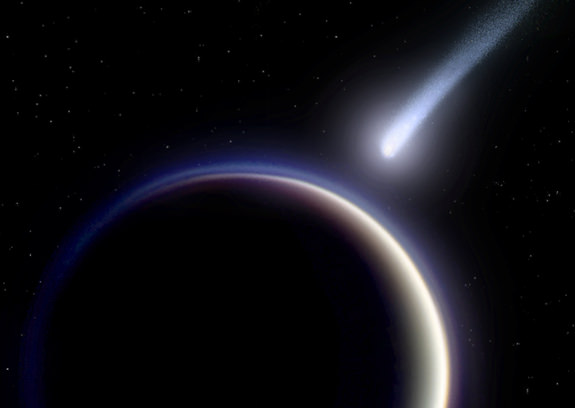science news
Extreme age challenges theories of black hole formation
By Nadia Drake

Astronomers peering at the early universe have glimpsed the most distant quasar yet. Powered by a black hole of 2 billion solar masses, the quasar appears as it did 12.9 billion years ago, when the universe as humans know it was just beginning to emerge from the Big Bang.
The supermassive black hole is pulling enormous clumps of matter into its gravitational clutches. As a result, the quasar emits 60 trillion times as much light as the sun, an international team reports in the June 30 Nature.
The team identified the object from the U.K. Infrared Telescope’s Infrared Deep Sky Survey, which probes 5 percent of the sky in infrared wavelengths. Daniel Mortlock of Imperial College London, an author of the study, likens the process to panning for gold. “You see many shiny things in the infrared, but not all of them are nuggets,” he says. “We got a big nugget this time.”
Already, the uncharismatically named ULAS J1120+0641 is presenting both clues and puzzles about the early universe.
“The surprising thing is that this object is right at the farthest possible distance we could see,” Mortlock says. The object is so distant that because of the time it took the quasar’s light to reach Earth, astronomers are seeing it as it was just 770 million years after the Big Bang. While theorists had predicted quasars could form that soon after the Big Bang, none had anticipated seeing one so large in the embryonic universe.
“It is like finding a 6-foot-tall child in kindergarten,” says astrophysicist Marta Volonteri, at the University of Michigan in Ann Arbor.
Prevailing theories suggest that black holes form either from the tiny, dense objects left behind after the deaths of early stars, or they form from the direct collapse of cosmic gases. For the first theory to be correct, Volonteri says, ULAS J1120+0641 would have needed to begin growing before the beginning of time, suggesting that the direct collapse theory is better supported by the quasar’s discovery.
Scientists think there are maybe 100 distant, bright objects like the newly discovered quasar sprinkled throughout the entire sky, and astrophysicist Avi Loeb, at Harvard University, says he hopes sky surveys will find more of them. These quasars, if they exist, could act as beacons of light that help astronomers study the early universe.
The next steps include finding more of these giants in the early cosmic playground and studying the quasar’s neighborhood using different wavelengths.
The discovery is intriguing, notes Chris Willott, of National Research Council Canada, but he adds some caution: “This could be one charmed place in the universe where things are going on very quickly,” he says. “It’s always dangerous if you base everything you know on one object.”
Examining the Great Wall
by on May 10, 2011

Structure exists on nearly all scales in the universe. Matter clumps under its own gravity into planets, stars, galaxies, clusters, and superclusters. Beyond even these in scale are the filaments and voids. The largest of these filaments is known as the Sloan Great Wall. This giant string of galaxies is 1.4 billion light years across making it the largest known structure in the universe. Yet surprisingly, the Great Wall has never been studied in detail. Superclusters within it have been examined, but the wall as a whole has only come into consideration in a new paper from a team led by astronomers at Tartu Observatory in Estonia.
A Cometary Case for Titan’s Atmosphere

Ancient comets may have created Titan's nitrogen-rich atmosphere
Titan is a fascinating world to planetary scientists. Although it’s a moon of Saturn it boasts an opaque atmosphere ten times thicker than Earth’s and a hydrologic cycle similar to our own – except with frigid liquid methane as the key component instead of water. Titan has even been called a living model of early Earth, even insofar as containing large amounts of nitrogen in its atmosphere much like our own. Scientists have wondered at the source of Titan’s nitrogen-rich atmosphere, and now a team at the University of Tokyo has offered up an intriguing answer: it may have come from comets.
